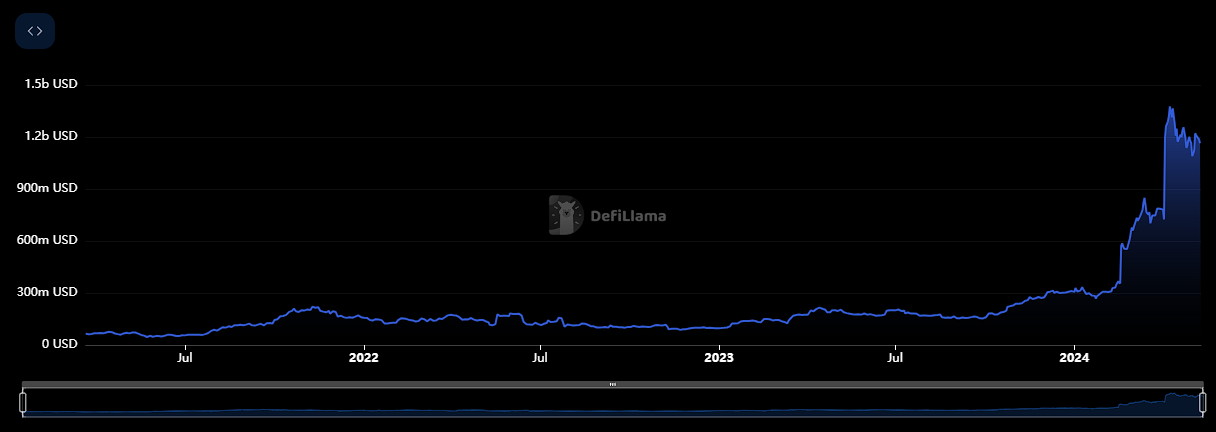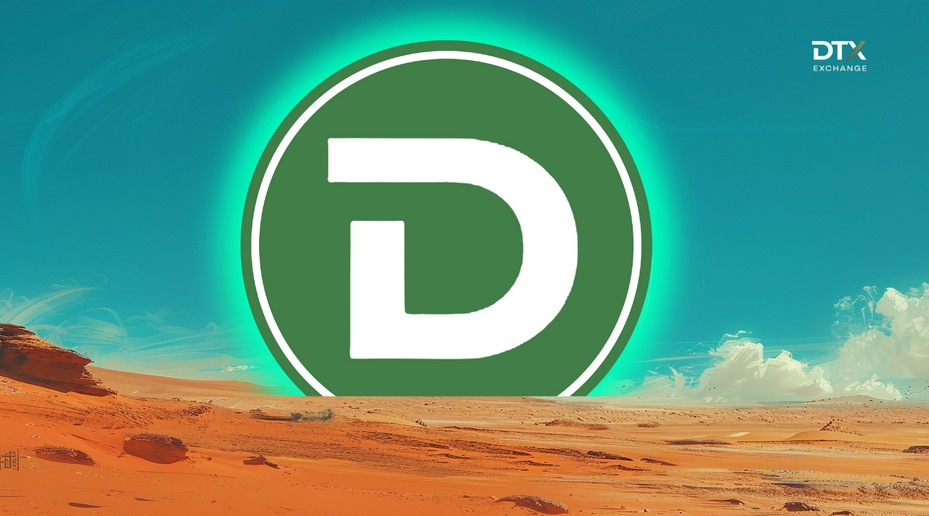DeFi
Institutions are likely to be interested in Bitcoin DeFi applications

Last updated: May 10, 2024, 5:01 p.m. EDT | 6 minutes of reading

Bitcoin (BTC) is evolving rapidly. Although the Bitcoin network has been primarily used for payment transactions, current activity appears to resemble that of Ethereum during the height of decentralized application (Dapp) projects.
The introduction of Bitcoin Runes and BRC-20 tokens – which emerged at the time of fourth Bitcoin halvedt – likely sparked the evolution of Bitcoin’s native decentralized finance (DeFi).
The emergence of Bitcoin DeFi
Rena Shah, VP of Product at Trust Machines – a team focused on growing the Bitcoin economy – told Cryptonews that two years ago, Bitcoin DeFi was not a narrative the ecosystem was discussing.
However, Shah noted that the emergence of staking platforms and lending protocols on the Bitcoin network have sparked investor interest in transitioning assets from a store of value to a source of value.
The growth of the Bitcoin DeFi (BTCFI) ecosystem is astounding 🧡
🟧 @ALEXLabBTC leading the charge, with @Bitflow_Finance & @StackingDao following.
– Data from @signal21btc pic.twitter.com/87MP5hMCbL
– stacks.btc (@Stacks) May 8, 2024
“The desire to move from a passive Bitcoin asset to a productive asset is real in 2024,” she said. “We are building this future because we can see that Bitcoin DeFi attracts not only retail investors but also institutional investors.”
Institutions will show interest in Bitcoin DeFi
Data from DeFiLlama watch that the total value locked (TVL) of Bitcoin is approximately $1.2 billion. Yet, according to Shah, nearly $1 trillion in capital is locked on the Bitcoin blockchain.
“Even the smallest percentages of capital that become productive in DeFi will make huge waves in the Bitcoin ecosystem,” Shah emphasized.
This, along with the recent approval of Spot Bitcoin exchange-traded funds (ETFs) in the United States, increases the potential of Bitcoin DeFi applications. In particular, this will likely appeal to Bitcoin-holding institutions and retail investors.

Tycho Onnasch, the co-founder of Zest Protocol, told Cryptonews that he believes BTC is a more institutional asset than the rest of crypto.
“Therefore, I expect institutions to play a larger role in using and starting Bitcoin DeFi,” Onnasch said.
Bitcoin DeFi Apps for Institutions
Although Bitcoin DeFi is still a relatively new concept, a number of projects aim to enable and advance the sector.
For example, Onnasch explained that Zest Protocol is creating a lending protocol specifically for Bitcoin. He mentioned that the aim of the platform is to create permissionless financial infrastructure for BTC lending markets.
“Zest allows users to collateralize BTC to borrow other tokens such as stablecoins,” he said. “The platform also allows users to earn yield on their BTC.”
Indeed, the primary use case for Bitcoin DeFi applications appears to be to ensure that Bitcoin becomes a more productive asset for investors.
Dr. Chiente Hsu, co-founder of ALEX and XLink, told Cryptonews that Alex is a new financial layer for the Bitcoin network.
“Our goal is to seamlessly integrate Bitcoin with Layer 2 (L2) solutions and the Ethereum Virtual Machine (EVM) world,” Hsu said. “This will allow us to grow the Bitcoin economy,” Hsu said.
For example, Hsu explained that investors can earn a return on their BTC by connecting a Bitcoin Wallet to XLink. He noted that XLink is powered by ALEX’s Automated Market Maker (AMM) and Decentralized Exchange (DEX). This will enable cross-chain exchanges between Bitcoin L2 and the EVM world.
“Bitcoin DeFi for institutions will be looking for Bitcoin yield generating assets,” Hsu said.
Hsu believes this is likely to be the case due to the amount of capital present on the Bitcoin network.
“There is well over $1 trillion of Bitcoin capital that is ‘idle’ in the sense that its value rises and falls relative to the Bitcoin spot price,” he said. “But unlike Ethereum, Bitcoin cannot be natively locked to generate yield. This is a solution that ALEX is actively pursuing, which will allow institutions holding Bitcoin to earn a return on their Bitcoin capital.
Bitcoin DeFi resembles its Ethereum counterparts
Another interesting point is that even though Bitcoin DeFi is unique, applications tend to look like DeFi projects on Ethereum (ETH). This is important to consider as institutions have started to show interest in many current DeFi applications.
Digital asset management company Fireblocks have recently seen increased institutional DeFi activity on the Fireblocks platform. According to the firm, there was a 75% jump in the first quarter of 2024.
Fireblocks reported that some of the most popular Dapps that institutional clients interact with when trading, lending, staking, and bridging include Uniswap, Aave, Curve, 1inch, and Jupiter.
Jeff Yin, CEO of Merlin Chain – a Bitcoin L2 facilitating fast and profitable transactions with support for BTC Dapps – told Cryptonews that DEXs, derivatives and lending are all areas where BTC has learned a lot from lending. ‘ETH. He added that many new protocols are emerging.
“For example, “Surf” is a derivatives trading protocol launched on Merlin Chain and now boasts a daily trading volume of over $10 million. These are similar to their Ethereum counterparts,” Yin said.
Yin explained that a specific Bitcoin DeFi application would replicate one of the largest ETH DeFi Protocols, Lido – which holds $28 billion and represents half of Ethereum’s DeFi TVL.
“SolvBTC is currently developing an underlying BTC yield protocol,” Yin said. “Additionally, Unicross has implemented a Rune trading protocol on a BTC L2, allowing users to trade layer 1 (L1) assets at a lower cost on L2. These represent the most innovative aspects of the sector.
Bitcoin DeFi Could Overtake Ethereum
Although Bitcoin DeFi may resemble Ethereum, Shah believes that decentralized finance using BTC could eventually surpass Ethereum.
“Look DappRadar, Ethereum has over 600 active applications with varying volume and activity,” Shah said. “I have no reason to expect that Bitcoin DeFi cannot match Ethereum, and eventually replace it with Dapps in the ecosystem.”
Some solutions also make it easier to introduce Ethereum Dapps on Bitcoin.
Zack Voell, director of marketing at Botanix Labs, told Cryptonews that Botanix has created a “Spiderchain” that easily enables DeFi on Bitcoin.
“Spiderchain creates a fully EVM-equivalent environment for Dapps and smart contracts on Ethereum to be copy-pasted to run natively on Bitcoin,” Voell said. “Botanix Labs is building the Spiderchain to combine the two most Lindy technologies in crypto – EVM and Bitcoin – instead of trying to reinvent a whole new protocol or virtual machine.”
Challenges can slow adoption
Although it is too early to determine the fate of Bitcoin DeFi, there are some challenges that could slow its adoption.
For example, Yin pointed out that liquidity fragmentation often results from the difficulty of implementing DeFi on an L1 network. This in turn forces most activities to disperse through various L2 solutionsbut Yin noted that this could make it difficult to concentrate liquidity.
“One potential solution could be to create omnichain liquidity, similar to the Stone protocol in the Ethereum ecosystem,” he said. “We look forward to future implementations such as M-STONEBTC and Solv Protocol that could unify BTC L2 liquidity.”
Furthermore, Shah mentioned that the challenge of Bitcoin is to keep the base layer secure, stable and unaltered.
“This is where scaling becomes critical,” she said. “A healthy and diverse L2 ecosystem will be what ultimately allows Bitcoin DeFi, as a vertical, to succeed.”
Shah added that programming environments on Bitcoin are inherently difficult because many developers in other ecosystems are less familiar with Bitcoin scripting.
She stressed that one way to combat this phenomenon is to create WebAssembly (WASM) or different runtime environments like Rust, Solidity and Cosmos with L2.
“This approach will likely help attract new developers to the ecosystem,” she noted.
DeFi
Cryptocurrency and defi firms lost $266 million to hackers in July

In July 2024, the cryptocurrency industry suffered a series of devastating attacks, resulting in losses amounting to approximately $266 million.
Blockchain Research Firm Peck Shield revealed in an X post On August 1, attacks on decentralized protocols in July reached $266 million, a 51% increase from $176 million reported in June.
The most significant breach last month involved WazirX, one of India’s largest cryptocurrency exchanges, which lost $230 million in what appears to be a highly sophisticated attack by North Korean hackers. The attack was a major blow to the stock market, leading to a break in withdrawals. Subsequently, WazirX launched a program in order to recover the funds.
Another notable incident involved Compound Finance, a decentralized lending protocol, which suffered a governance attack by a group known as the “Golden Boys,” who passed a proposal who allocated 499,000 COMP tokens – valued at $24 million – to a vault under their control.
The cross-chain liquidity aggregation protocol LI.FI also fell victim On July 16, a hack resulted in losses of $9.73 million. Additionally, Bittensor, a decentralized machine learning network, was one of the first protocols to suffer an exploit last month, loming $8 million on July 3 due to an attack targeting its staking mechanism.
Meanwhile, Rho Markets, a lending protocol, suffered a $7.6 million breach. However, in an interesting twist, the exploiters research to return the stolen funds, claiming the incident was not a hack.
July 31, reports The Terra blockchain protocol was also hacked, resulting in a loss of $6.8 million across multiple cryptocurrencies. As crypto.news reported, the attack exploited a reentrancy vulnerability that had been identified a few months ago.
Dough Finance, a liquidity protocol, lost $1.8 million in Ethereum (ETH) and USD Coin (USDC) to a flash loan attack on July 12. Similarly, Minterest, a lending and borrowing protocol, saw a loss of $1.4 million due to exchange rate manipulation in one of its markets.
Decentralized staking platform MonoSwap also reported a loss of $1.3 million following an attack that allowed the perpetrators to withdraw the liquidity staked on the protocol. Finally, Delta Prime, another decentralized finance platform, suffered a $1 million breach, although $900,000 of the stolen funds was later recovered.
DeFi
Centralized crypto exchanges are slowly losing ground to their DeFi counterparts

Centralized crypto exchanges are slowly losing ground to their DeFi counterparts, according to an in-depth data analysis conducted by Decrypt.
DeFiLlama’s decentralized exchange (DEX) volume data and CoinGecko’s total cryptocurrency trading volume data show that the percentage of cryptocurrency trading volume occurring on DEXs relative to total trading volume has increased from 4.6% in February to over 7% this month. This is an increase in the share of trading volume driven by DEXs of over 52%.
Source: Adrian Zmudzinski
Kunal Goel, a senior research analyst at Messari, told Decrypt that several factors are fueling the growth in DEX market share. He cited “the growth of meme coins and long-tail assets” as one of the reasons, explaining that they tend to list first on DEXs and only appear on centralized exchanges much later.if they last that long.
“The onchain user experience has improved with low fees and high throughput on Solana and Ethereum L2,” he added, highlighting advancements making decentralized finance (DeFi) solutions increasingly easier to use.
DeFiLlama data further shows that over the past 24 hours, DEX volume accounted for 22% of total trading volume. The crypto price aggregator notes that this percentage is meant to represent the dominance of decentralized exchanges over aggregated decentralized exchanges and centralized exchanges.
So far in 2024, DEX volume has seen a slow and steady increase.
CEX and DEX trading volume increased from $133.5 billion in January to $179.5 billion this month, an increase of about 34%. The year-to-date high was recorded in March, when CEX and DEX volumes saw a sharp increase, reaching $4.8 trillion and $266.89 billion, respectively.
Goel noted that at the time, “Bitcoin hit new all-time highs in March and trading activity is generally positively correlated with price and sentiment.” Looking ahead, he expects centralized exchanges to move on-chain and disrupt their own business models before others can. He added that “Base and BNB Chain are the most prominent examples of this.”
TradingView also shows a DeFi market cap dominance chart, in percentage terms. Currently at 3.86%, it fell from 4.47% on January 1 and hit a 2024 high of 4.81% on February 25. Goel noted that this was unexpected since “DEX volumes are a key driver of DEX value, so it’s a bit contradictory.”
Challenge is an umbrella term for a group of financial tools built on a blockchain, including DEXs, exchanges that operate primarily on-chain. The primary goal of DeFi is to allow anyone with internet access to lend, borrow, and bank without relying on intermediaries.
Similarly, the main goal of DEXs is to allow anyone with internet access to trade or even provide liquidity in exchange for a stake. DeFi and DEXs are one of the main areas of focus in decentralized application (dapp) development, which have seen considerable adoption this year.
Edited by Stacy Elliott.
DeFi
Pump.Fun Overtakes Ethereum in Daily Revenue: A New Leader in DeFi

In a remarkable turn of events, Pump.Fun, a memecoin launchpad, has surpassed all other platforms in the decentralized finance (DeFi) sector, achieving the highest gross revenue in the last 24 hours. According to data from DeFiLlama, Pump.Fun amassed $867,429 during this period, surpassing Ethereum’s $844,276. This achievement underscores the growing influence of memecoin infrastructure within DeFi.
Pump.Fun Revenue Milestones
The impressive revenue numbers go beyond daily performance. Pump.Fun is generating $315 million in annualized revenue, averaging $906,160 per day over the past week. This revenue surge is largely due to the recent memecoin frenzy, with Solana-based memecoins being particularly popular among on-chain enthusiasts. The platform’s user-friendly interface allows non-technical users to quickly launch their own tokens, spending as little as $2 without needing to provide any initial liquidity.
How Pump.Fun works
Pump.Fun’s operating model is designed to facilitate the use and rapid launch of tokens. Users can create new tokens in minutes, which are then allowed to trade along a bonding curve until they reach a market cap of approximately $75,000. At this point, the bonding curve is burned on Raydium, establishing a secure liquidity pool. The platform generates revenue through a 1% fee on transactions made on the platform. However, once a token is bonded and burned on Raydium, Pump.Fun stops charging this fee.
Ethereum: Traditional Power
Despite its daily revenues, Ethereum remains a cornerstone of the DeFi ecosystem. It is the blockchain of Ether, the second-largest cryptocurrency with a market cap of $395 billion. Ethereum powers many applications and digital assets, backing over $60 billion worth of smart contracts. Revenue generation on Ethereum is done through transaction fees, called gas, which are paid in ETH for executing transactions and smart contracts.
Comparative analysis of revenue models
While Ethereum’s revenue model relies on gas fees for transactions and smart contract executions, Pump.Fun takes a different approach. By enabling easy and low-cost token launches, Pump.Fun caters to a broad audience, including non-technical users. This inclusiveness, combined with the excitement surrounding memecoins, has led to rapid revenue growth. The 1% transaction fee ensures continued revenue generation until the token transitions to Raydium, creating a sustainable business model.
Memecoin frenzy
The recent rise in popularity of memecoins has been a major contributor to Pump.Fun’s success. Memecoins, particularly those based on Solana, have captivated the DeFi community, generating substantial activity on platforms like Pump.Fun. This trend highlights a shift in DeFi dynamics, where niche platforms catering to specific interests can achieve significant revenue milestones.
Future prospects
Pump.Fun’s recent successes suggest a potential shift in the DeFi landscape. As the platform continues to attract users with its simple token launch process and low-cost entry point, it could solidify its position as a leader in the DeFi space. The memecoin phenomenon shows no signs of slowing down, indicating that platforms like Pump.Fun could continue to see robust growth.
In conclusion, Pump.Fun’s ability to surpass Ethereum in terms of daily revenue underscores the evolving nature of the DeFi space. By providing a user-friendly platform for launching memecoins, Pump.Fun has tapped into a lucrative niche, demonstrating the potential for niche platforms to thrive alongside traditional blockchain giants like Ethereum. This development signals a broader trend toward diversification and innovation within the DeFi ecosystem, with new entrants challenging established players through unique value propositions and targeted services.
DeFi
$10 Billion Venture Firm May Target 10x Opportunities in Ripple (XRP) and This DeFi Token

According to recent reports, one of the largest venture capital firms is looking for new opportunities in the cryptocurrency space as Bitcoin (BTC) attempts to break its all-time high and start a new bull run in the cryptocurrency market. They are balancing risk with low-risk, low-reward and high-risk, high-reward opportunities.
The first investment candidate is a top cryptocurrency, Ripple (XRP); it doesn’t have much growth potential because it’s already a large cap. Another scenario the firm is targeting is DTX ExchangeThe new hybrid exchange is expected to revolutionize the foreign exchange industry. According to analysts, its growth potential is immense and the risk is also very limited due to its low price.
Market is bullish as Trump wants to make US a Bitcoin (BTC) superpower
Over the past 30 days, Bitcoin (BTC) has increased by about 10%, and one of the catalysts for this price increase has been Donald Trump recently speaking out as a crypto pro. Presidential candidate Donald Trump has promised to make the United States the world leader in cryptocurrencies if elected in November. Speaking at the Bitcoin2024 conference in Nashville, Trump compared Bitcoin (BTC) to the steel industry of 100 years ago, highlighting its potential.
Trump’s plans include firing SEC Chairman Gary Gensler and immediately creating a “Presidential Advisory Council on Bitcoin (BTC) and Cryptocurrencies.” He stressed the importance of American leadership in the cryptocurrency space, saying, “I am laying out my plan to ensure that the United States is the cryptocurrency capital of the planet and the Bitcoin (BTC) superpower of the world.”
$600 Million Worth of Ripple (XRP) to Be Released in August
Ripple (XRP), the company behind the XRP Ledger blockchain and its native token Ripple (XRP), unlocks up to 1 billion tokens on the first day of every month. Since 2017, they have used several major escrow wallets, including Ripple (XRP) (24) and Ripple (XRP) (25), to evenly distribute these monthly unlocks.
However, Ripple (XRP) often relocks a large portion of newly issued XRP. For example, on June 1, Ripple (XRP) relocked 800 million XRP but still sold about 300 million XRP, worth $182 million at the time.
While Ripple (XRP) releases up to 1 billion XRP tokens each month, the actual amount released into circulation is typically much lower due to this re-escrow process, as noted in a 2017 XRP Ledger blog post.
DTX Exchange Follows Bitcoin (BTC) Path
The main target of large private equity firms is the DTX exchange (DTX), the reason being a clearly high utility like Bitcoin (BTC). This project has attracted global attention thanks to its exceptional pre-sale performance, offering early buyers a 100% return on investment and raising over $1 million. Projections suggest that this figure will reach $2 million by the end of August 2024.
DTX Exchange offers a revolutionary hybrid trading platform, combining the best features of centralized (CEX) and decentralized (DEX) exchanges. Traders can enjoy a seamless experience with access to over 120,000 asset classes, no KYC verification upon registration and ultra-fast transaction speeds of 0.04 seconds.
These benefits have attracted traders to this new cryptocurrency exchange. Currently, in Phase 2 of its pre-sale, DTX Exchange is listed at $0.04, which is double its starting price of $0.02. Market analysts predict that the upcoming listing of DTX Exchange on the Level 1 CEX in late 2024 could trigger a 100x bullish rally, making DTX Exchange the top cryptocurrency exchange to watch.
Learn more:
Disclaimer: The statements, views and opinions expressed in this article are solely those of the content provider and do not necessarily represent those of Crypto Reporter. Crypto Reporter is not responsible for the reliability, quality and accuracy of the materials contained in this article. This article is provided for educational purposes only. Crypto Reporter is not responsible or liable, directly or indirectly, for any damage or loss caused or alleged to be caused by or in connection with the use of or reliance on any content, goods or services mentioned in this article. Do your research and invest at your own risk.
-

 Videos9 months ago
Videos9 months agoCrypto News: Bitcoin, ETH Price, CPI Print, PYTH, WIF & MORE!!
-

 Videos9 months ago
Videos9 months agoCrypto News: Bitcoin Price, ETF, ETH, WIF, HNT & MORE!!
-

 DeFi9 months ago
DeFi9 months agoMetasphere Labs announces follow-up event regarding
-

 Videos9 months ago
Videos9 months agoSolana price potential?! Check out THIS update if you own SOL!!
-

 Videos8 months ago
Videos8 months agoWho Really CONTROLS THE MARKETS!! Her plans REVEALED!!
-

 DeFi6 months ago
DeFi6 months agoPump.Fun Overtakes Ethereum in Daily Revenue: A New Leader in DeFi
-

 DeFi6 months ago
DeFi6 months agoDegens Can Now Create Memecoins From Tweets
-

 News6 months ago
News6 months agoNew bill pushes Department of Veterans Affairs to examine how blockchain can improve its work
-

 News6 months ago
News6 months agoLawmakers, regulators to study impact of blockchain and cryptocurrency in Alabama • Alabama Reflector
-

 Bitcoin6 months ago
Bitcoin6 months ago1 Top Cryptocurrency That Could Surge Over 4,300%, According to This Wall Street Firm
-

 Ethereum8 months ago
Ethereum8 months agoComment deux frères auraient dérobé 25 millions de dollars lors d’un braquage d’Ethereum de 12 secondes • The Register
-

 Videos8 months ago
Videos8 months agoCryptocurrency News: BTC Rally, ETH, SOL, FTM, USDT Recover & MORE!





